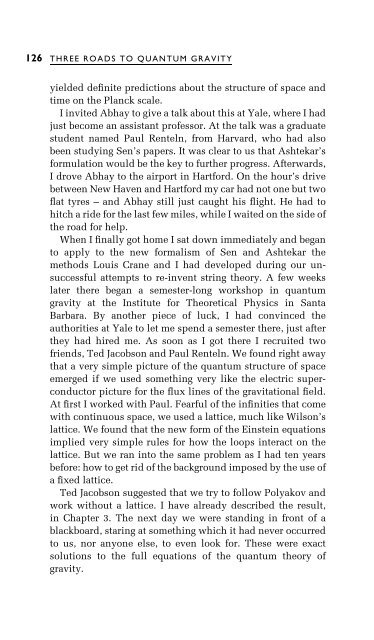Three Roads To Quantum Gravity
Three Roads To Quantum Gravity
Three Roads To Quantum Gravity
Create successful ePaper yourself
Turn your PDF publications into a flip-book with our unique Google optimized e-Paper software.
126 THREE ROADS TO QUANTUM GRAVITY<br />
yielded de®nite predictions about the structure of space and<br />
time on the Planck scale.<br />
I invited Abhay to give a talk about this at Yale, where I had<br />
just become an assistant professor. At the talk was a graduate<br />
student named Paul Renteln, from Harvard, who had also<br />
been studying Sen's papers. It was clear to us that Ashtekar's<br />
formulation would be the key to further progress. Afterwards,<br />
I drove Abhay to the airport in Hartford. On the hour's drive<br />
between New Haven and Hartford my car had not one but two<br />
¯at tyres ± and Abhay still just caught his ¯ight. He had to<br />
hitch a ride for the last few miles, while I waited on the side of<br />
the road for help.<br />
When I ®nally got home I sat down immediately and began<br />
to apply to the new formalism of Sen and Ashtekar the<br />
methods Louis Crane and I had developed during our unsuccessful<br />
attempts to re-invent string theory. A few weeks<br />
later there began a semester-long workshop in quantum<br />
gravity at the Institute for Theoretical Physics in Santa<br />
Barbara. By another piece of luck, I had convinced the<br />
authorities at Yale to let me spend a semester there, just after<br />
they had hired me. As soon as I got there I recruited two<br />
friends, Ted Jacobson and Paul Renteln. We found right away<br />
that a very simple picture of the quantum structure of space<br />
emerged if we used something very like the electric superconductor<br />
picture for the ¯ux lines of the gravitational ®eld.<br />
At ®rst I worked with Paul. Fearful of the in®nities that come<br />
with continuous space, we used a lattice, much like Wilson's<br />
lattice. We found that the new form of the Einstein equations<br />
implied very simple rules for how the loops interact on the<br />
lattice. But we ran into the same problem as I had ten years<br />
before: how to get rid of the background imposed by the use of<br />
a ®xed lattice.<br />
Ted Jacobson suggested that we try to follow Polyakov and<br />
work without a lattice. I have already described the result,<br />
in Chapter 3. The next day we were standing in front of a<br />
blackboard, staring at something which it had never occurred<br />
to us, nor anyone else, to even look for. These were exact<br />
solutions to the full equations of the quantum theory of<br />
gravity.



![arXiv:1001.0993v1 [hep-ph] 6 Jan 2010](https://img.yumpu.com/51282177/1/190x245/arxiv10010993v1-hep-ph-6-jan-2010.jpg?quality=85)


![arXiv:1008.3907v2 [astro-ph.CO] 1 Nov 2011](https://img.yumpu.com/48909562/1/190x245/arxiv10083907v2-astro-phco-1-nov-2011.jpg?quality=85)








![arXiv:1002.4928v1 [gr-qc] 26 Feb 2010](https://img.yumpu.com/41209516/1/190x245/arxiv10024928v1-gr-qc-26-feb-2010.jpg?quality=85)
![arXiv:1206.2653v1 [astro-ph.CO] 12 Jun 2012](https://img.yumpu.com/39510078/1/190x245/arxiv12062653v1-astro-phco-12-jun-2012.jpg?quality=85)
